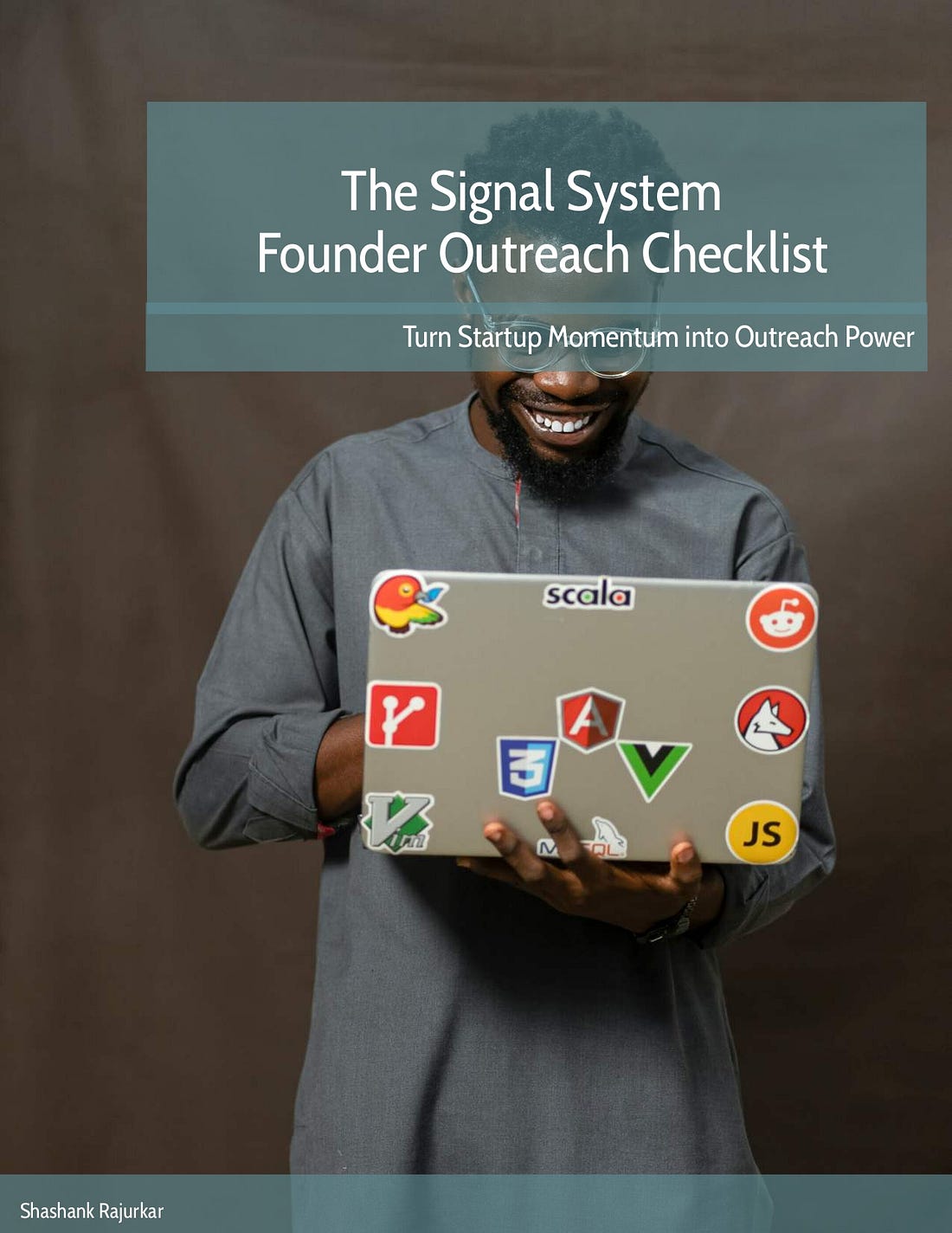Every founder I know struggles with outreach. Some ghost people after one post. Others spray DMs like confetti. Most just burn out trying to get noticed. But here’s the quiet truth I learned after hundreds of founder calls — The founder who never chased attentionA few months ago, I met a founder who didn’t send a single cold DM. No viral thread. No fancy funnels. Just simple weekly posts: No hype. Just motion. And yet, he started getting inbound intros, investor messages, and beta sign-ups — all from people who said, “I’ve been following your updates; looks like you’re really moving.” That’s when it clicked: Outreach doesn’t start with a message. The problem with “cold”Cold outreach is like knocking on a door with no name on it. You might get lucky — but more often, people don’t open because they don’t trust who’s knocking. Founders don’t have a marketing problem as much as a trust visibility problem. That’s what led me to build something small but powerful — a checklist I call The Signal System. What The Signal System doesIt helps you turn the progress you’re already making — your launches, lessons, even mistakes — into visible proof of momentum. Instead of “Look at me,” your message becomes,
That subtle shift changes everything. Why it worksPeople trust founders who are in motion. When you show consistent signals — not hype, just reality — And trust, once visible, compounds. The free checklistI turned this idea into a simple weekly habit guide: The Signal System Checklist. No funnels, no scripts — just momentum that markets itself. 📬 Get it free here → startup-side.in/the-signal-system-checklist Final thoughtIn a noisy world, founders who show progress beat those who talk about it. And your next big opportunity? |
Friday, October 31, 2025
💡 The Signal System: Turning Startup Motion into Magnetism
Wednesday, October 29, 2025
🧩 The Freemium Mirage: Why Hybrid Models Delay Real Learning
🧩 The Freemium Mirage: Why Hybrid Models Delay Real Learning(Part 2 of the Revenue-First Founder Series)
There’s a reason “freemium” feels comforting to founders — it promises growth without risk. It sounds rational. It even sounds generous. The Myth of “Safe Growth”Freemium was born in the 2000s, when distribution was scarce and user acquisition was expensive. Because when you don’t charge, you don’t know why people show up. That distinction — between curiosity and urgency — is what separates a busy funnel from a real business. The Hybrid IllusionTo avoid that uncertainty, founders invent “hybrid” models: On paper, it looks like balance.
And since free users vastly outnumber the paid ones, you end up building for the wrong crowd. Hybrid models are supposed to de-risk monetization, but often they just delay learning. A Familiar StoryWe’ve seen this movie many times. Closer home, Byju’s faced a similar challenge — millions of students loved the free lessons, but converting that engagement into sustainable revenue was much harder. Contrast that with Razorpay, which charged from day one. Why Hybrid Models Feel Right but Teach WrongBecause they let you avoid rejection. But the discomfort is where the truth hides. When you give things away, people smile and nod. The Hidden Cost of “Free”Free users don’t just distort feedback — they also distort your roadmap. Before long, you’re running a product museum: lots of visitors, no buyers. What the Data Actually SaysFreemium conversion rates have declined over the past decade. AI has made it even easier to copy features and launch alternatives. That’s why the next generation of founders is shifting from “freemium funnels” to revenue-first loops — start charging small, learn fast, iterate honestly. The 2020s Reality CheckAI startups like Midjourney and Runway flipped the old playbook. In India, Zoho followed the same logic years earlier — slow, steady, paid growth that produced one of the most resilient SaaS companies globally. Meanwhile, many “hybrid” startups are still burning resources trying to convert users who were never serious in the first place. What Founders Can Do Instead1️⃣ Charge early — even symbolically. 2️⃣ Treat free as a learning tool, not a business model. 3️⃣ Design for urgency, not curiosity. 4️⃣ Calibrate price as signal strength. The AI Era Makes the Shift Non-NegotiableAI has collapsed the cost of creation. In this new reality, revenue is not the reward — it’s the filter. If you can’t charge now, it’s not because users are “price sensitive.” And that’s exactly the data you need. Closing ReflectionHybrid models teach comfort, not conviction. Free makes people say yes. The best founders don’t avoid that friction — they design for it.
© 2025 Startup-Side |
People Don’t Buy Pain Relief. They Buy Progress.
Most startups fail because they confuse pain points with the Job to be done or accomplished. Pain triggers choice. JTBD drives meaning, iden...
-
Crypto Breaking News posted: "Mikhail Fedorov, Ukraine's Deputy Prime Minister and the head of the country's Minist...
-
kyungho0128 posted: "China's crackdown on Bitcoin (BTC) mining due to energy consumption concerns is widely regarded as...
-
admin posted: " A major British bank, Natwest, has put a limit on fund transfers to crypto...



